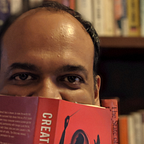The irrational user
Shouldn’t we treat users as irrational humans?
Richard Thaler, the Nobel Prize winning economist, talks about a mythical species that is real only to an economist. The Homo Economicus — he calls them Econ for short. An Econ is an extremely rational being and believes in maximizing utility with every decision they make. This is what a prototypical Econ looks and behaves like:
I believe when we designers look at users, we have a tendency to classify them similarly — as Homo Usabilitus. We expect them to respond to stated user needs and presume that they will behave rationally when it comes to immediate task at hand.
However as Dan Ariely, Daniel Kahneman and Richard Thaler have shown in their studies, human beings are innately irrational when it comes to making economic decisions. And I believe there is a parallel to this when it comes to making decisions about how they use software as well.
This task of making economics more human centered, is being spearheaded by the field of Behavioral Economics. A field that arose from the concept of Bounded Rationality that Herbert Simon coined.
Bounded rationality is the idea that when individuals make decisions, their rationality is limited by the tractability of the decision problem, the cognitive limitations of their minds, and the time available to make the decision. Decision-makers in this view act as satisficers, seeking a satisfactory solution rather than an optimal one.
Wikipedia
Herbert Simon was thinking of Bounded Rationality as an idea for economic decision making. However when you consider the concept from a point of view of user making decisions on an interface, we should have the same when we are evaluating usability and user experience.
I call this Bounded UX.
While a human centered approach to design does try and address this by putting the user needs at the center, we are still driven to a large extent by business needs. This tendency to lean towards the business side of things can be avoided by approaching a balanced value centered design approach. However we need to be a bit more cognitive about human irrationality.
For example, when performing usability tests, there are two types of feedback that can be captured from a user. The first is the ‘Recorded Feedback’ which is the whole purpose of running usability tests in a lab or using experience monitoring software like Lookback.
The second is a ‘Self-Reported Feedback’, where the user is asked to give their interpretation of how they completed the task. The general feeling is that Self Reported metrics tend to be more optimistic than recorded metrics and hence it is given lesser importance.
Similarly when evaluating design decisions based on A/B testing, the tendency is to rely completely on observed data. This observed data is what leads us to create our own designer mental model of the Homo Usabilitus. Which may end up being very different from what the human users feel.
Maybe as designers we should rely as much on self reported metrics as we rely on recorded metrics. And we should invest more in thinking about the irrationality behind user decisions and not just ignore them but rather design with them in mind.
For example, the “I’m feeling lucky” button on Google is probably never used and hence ideally should be removed for all Homo Usabilitus. However, for human users, having it as part of the interface communicates the confidence Google has in its search results. It helps bind the user experience into what can be called as Bounded UX.
We need to pay more attention to these features that help the users become not just satisficers but beyond that — euphoricers.
Originally published at www.navneetnair.com.
